battery capacity AUDI S8 2011 Owners Manual
[x] Cancel search | Manufacturer: AUDI, Model Year: 2011, Model line: S8, Model: AUDI S8 2011Pages: 302, PDF Size: 76.07 MB
Page 71 of 302
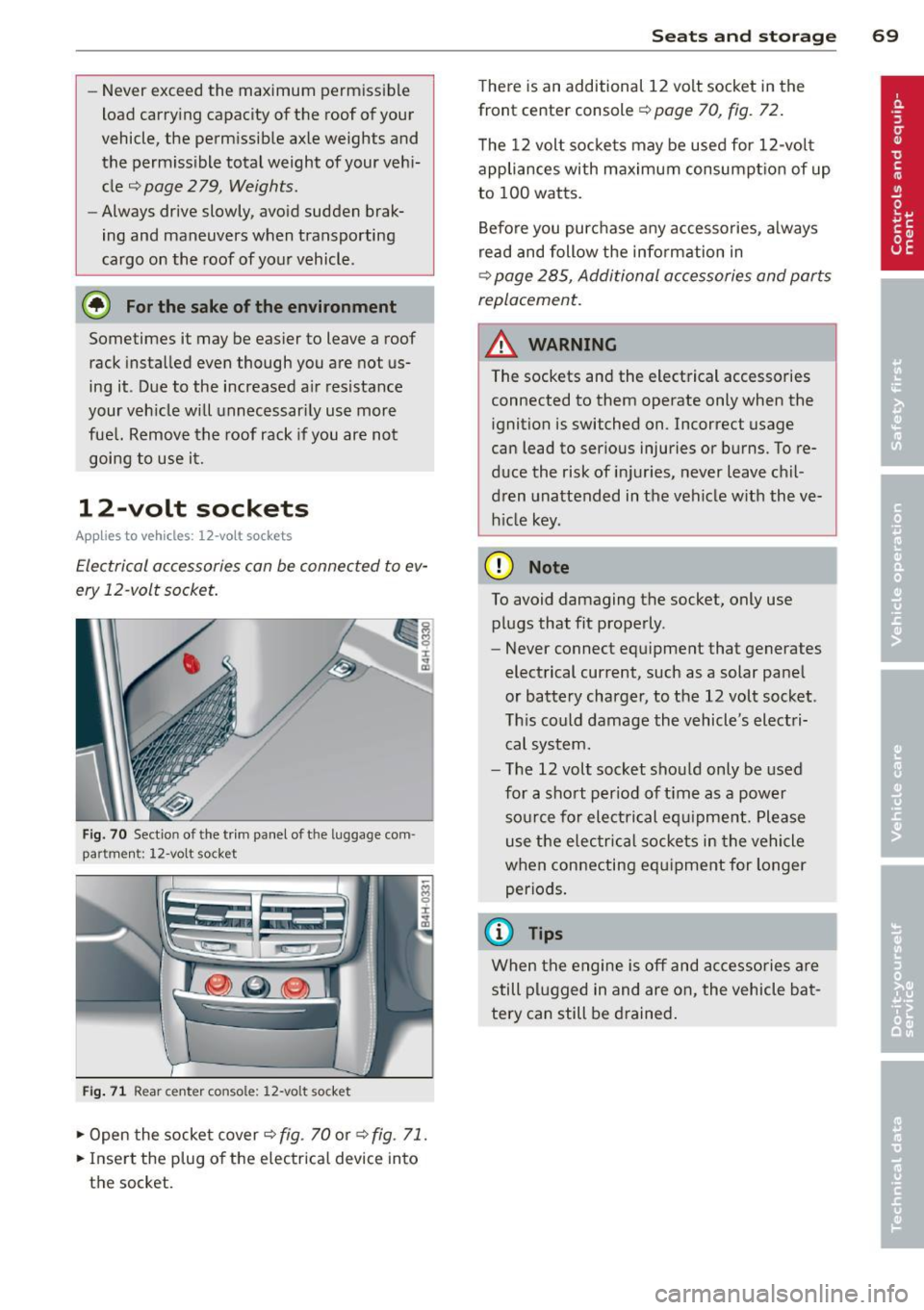
-Never exceed the maximum permissible
load carry ing capacity of the roof of your
vehicle, the perm issible axle weights and
the permiss ible total weight of your veh i
cle
~ page 2 79, Weights .
-Always drive slowly, avoid sudden brak
ing and maneuvers when transporting
cargo on the roof of your vehicle .
@) For the sake of the environment
Sometimes it may be easier to leave a roof
rack installed even though you are not us
ing it. Due to the increased a ir resistance
your vehicle will unnecessarily use more
fuel. Remove the roof rack if you are not
going to use it.
12-volt sockets
App lies to vehicles: 12-volt sockets
Electrical accessories can be connected to ev
ery 12 -volt socket.
Fig. 70 Sect io n of the trim panel of t he luggage com
p ar tm en t: 12 -v ol t so cke t
Fig . 71 R ear cente r c ons ole : 12 -vo lt s ocket
~ Open the socket cover ~ fig . 70 or ~ fig. 71.
~ Inse rt the plug o f the el ectrical device into
t h e socket.
S ea ts a nd s to rage 69
There is an additional 12 volt socket in the
front center console~
page 70, fig . 72.
T he 12 volt socke ts may be used for 12-volt
appliances with maximum consumpt ion of up
to 100 watts.
Before you purchase any accessories, always
read and follow the info rmation in
~ page 285 , Additional accessories and parts
replacement.
A WARNING
The sockets and the electrical accessories
connected to them operate only when the
ignition is switched on .1ncorrect usage
can lead to ser ious injuries or burns . To re
duce the risk of injuries, never leave chil
dren unattended in the vehicle w ith the ve
h icle key.
(D Note
To avoid damaging the socket, only use
plugs that fit properly .
- Never connect eq uipment that generates
electrical current, such as a solar panel
or battery charger, to the 12 volt socket .
Th is could damage the vehicle 's electri
cal system.
- The 12 volt socket sho uld only be used
for a short per iod of t i me as a powe r
so urce for electrical equipme nt. Please
use the elec trical sockets in the vehicle
when connecting equ ipment for longer
periods .
(D Tips
When the engine is off and ac ce ssories are
still plugged in and are on , the vehicle ba t
tery can still be drained .
Page 74 of 302
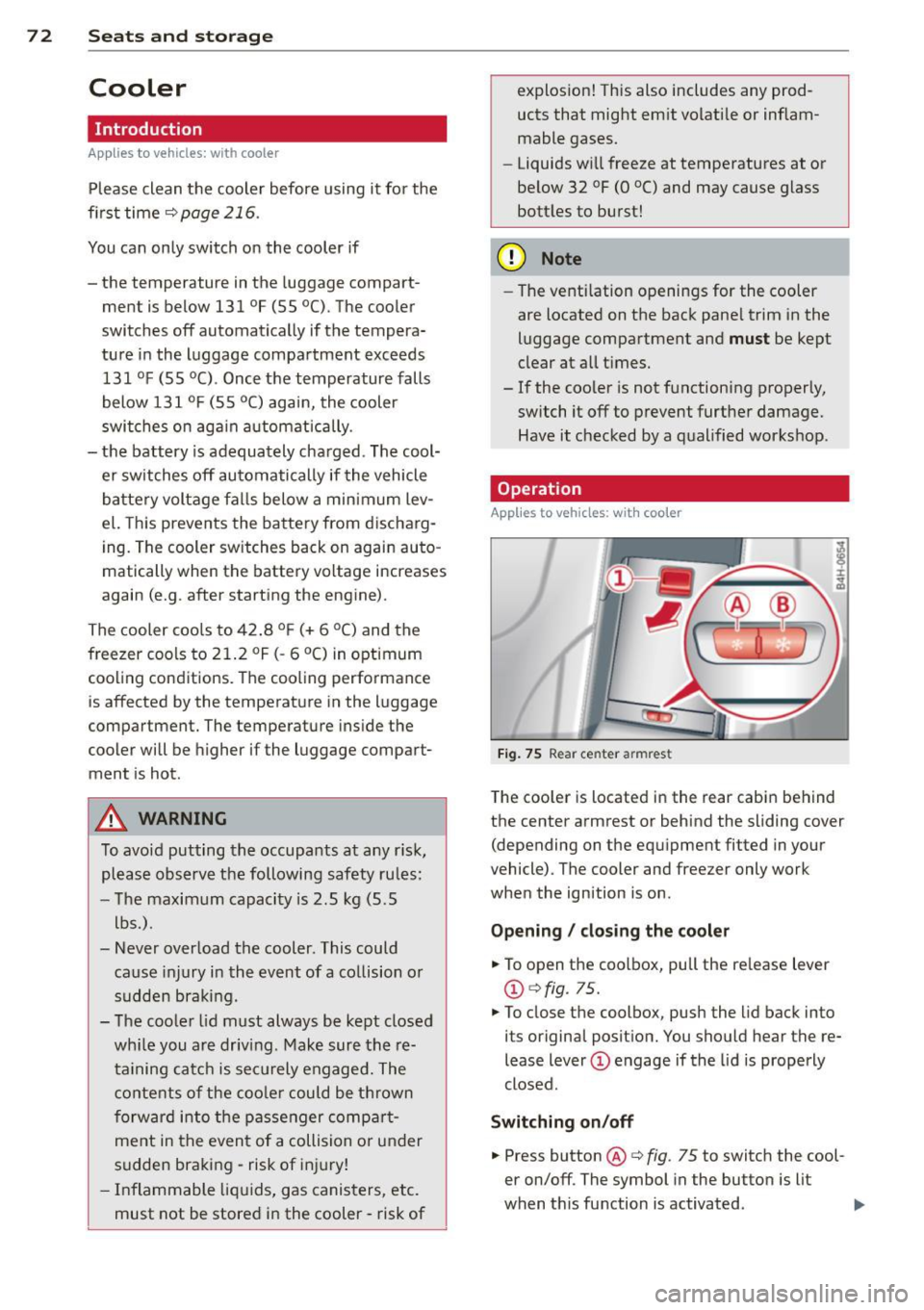
7 2 Seats and st o ra ge
Cooler
Introduction
Applies to vehicles: with cooler
Please clean the cooler before using it for the
first time~
page 216.
You can only switch on the cooler if
- the temperature in the luggage compart
ment is below 131 °F (55 °C). The cooler
switches off automatically if the tempera
ture in the luggage compartment exceeds 131 °F (55 °C) . Once the temperature falls
below 131 °F (55 °C) again, the cooler
swit ches on aga in automatically.
- the battery is adequately charged. The cool
er switches off automatically if the vehicle
ba ttery voltage fal ls below a minimum lev
el. This prevents the battery from d ischarg
i ng. The cooler switches back on again auto
matically when the battery voltage increases
again (e.g. after starting the engine).
The cooler coo ls to 42 .8
° F ( + 6 °c) and the
freezer cools to 2 1.2 °F (- 6 °C) in optimum
cooling cond itions. The cooling performance
is affected by the temperature in the luggage
compartment. The temperature inside the
cooler will be higher if the luggage compart
ment is hot.
.,&. WARNING
To avoid putting the occupa nts at any r isk,
please observe the following safety ru les:
- The maximum capacity is 2.5 kg (5 .5
lbs.).
- Never overload the cooler. This could cause injury in the event of a co llision o r
s u dden bra king.
- The coo le r li d must always be kept closed
wh ile you are driv ing. Make sure the re
taining catch is sec urely engaged . The
c o ntents of the coo le r could be thrown
forwar d into the passe nger comp art
ment in the event of a collision or u nder
s udden braking -risk of inj ury!
- Inflammable liq uids, g as canisters, etc.
must not be store d in the cooler -risk of explos
ion! This also includes any prod
ucts that might em it volati le or inflam
mable gases.
- Liquids w ill freeze at temperatures at or
be low 32 °F (0 °C) and may cause glass
bottles to burst!
(D Note
- The venti lation openings for the cooler
are located on the back pane l trim in the
luggage compartment and
must be kept
clear at a ll times.
- If the coo ler is not functioning properly,
switch it off to prevent furt her damage.
Have it checked by a qualified works hop.
Operation
Applies to vehicles: with coo ler
Fig. 75 Rear center armrest
The cooler is located in the rear cabi n behind
the center armrest or behind the sliding cover
(depending on the equipment fitted in your
vehicle). The cooler and freezer only work
when the ignition is on .
Opening / clos ing the co oler
.,. To open the coolbox, pull the re lease lever
@ qfig. 75.
.,. To close the coolbox, push the lid back into
its original position. You should hear the re
lease lever
(D engage if the lid is properly
closed.
Switching on /off
.,. Press button @ q fig. 75 to switch the cool
er on/off. The symbol in the button is lit
when t his function is activated. .,,_
Page 197 of 302
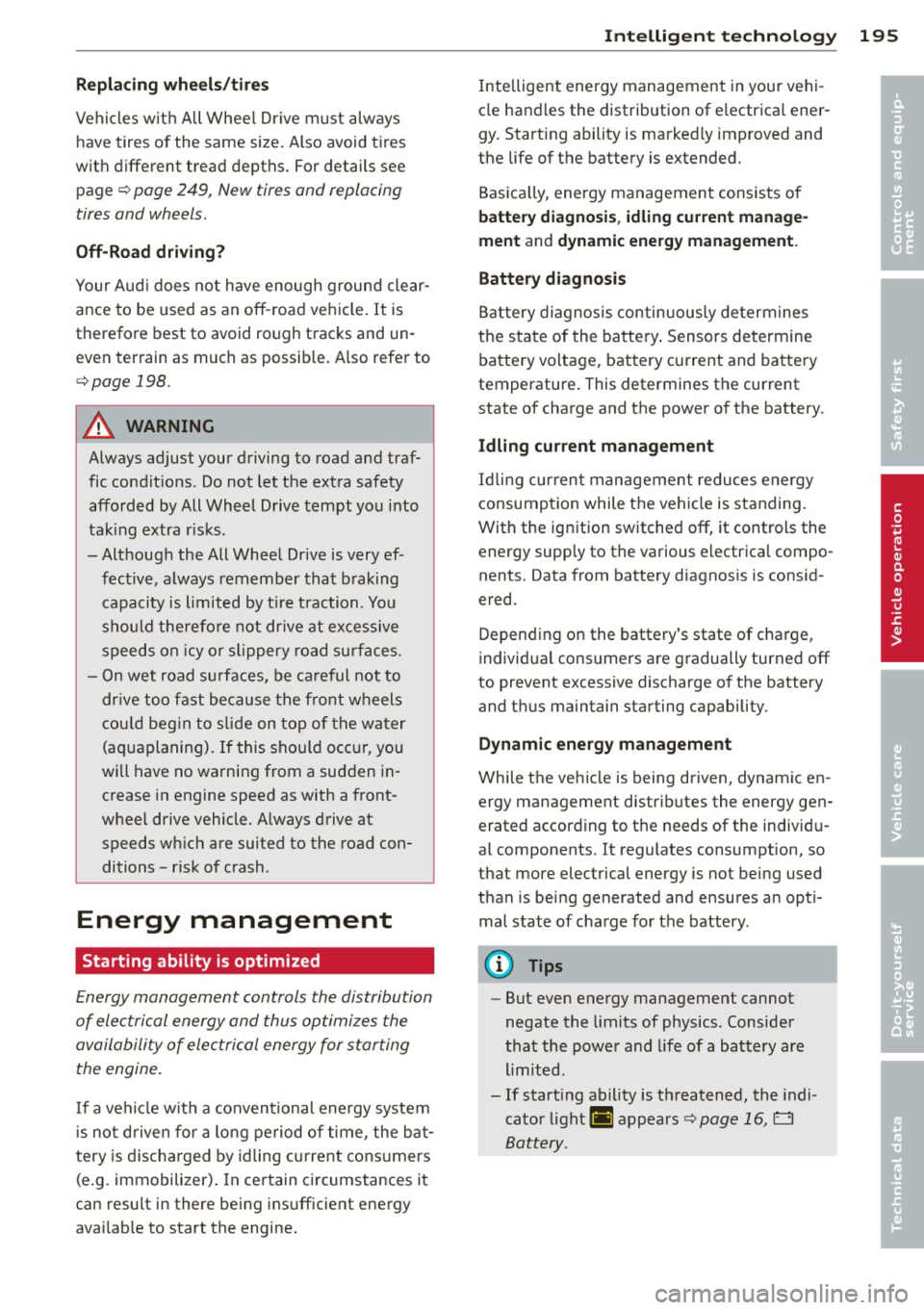
Replacing wh eels/ tire s
Vehicles w ith All Wheel Dr ive must always
have tir es of the same size. Also avoid tires
with different tread depths. For details see
pag e¢
page 249 , N ew tires and replacing
tires and wheels .
Off-Road driving?
Your Aud i does not have enough ground clear
ance to be used as an off -road vehicle. It is
therefor e best to avoid rough tracks and un
even terrain as much as possible . Also refer to
¢ page 198.
A WARNING
Always adjust your driving to road and traf
fic condit ions . Do not let the extra safety
afforded by All Wheel Drive tempt you into
taking extra risks.
- Although the All Wheel Drive is very ef
fective, always remember that braking
capacity is limited by t ire traction . Yo u
should the refore not dr ive at excessive
speeds on icy or s lippery road surfaces.
- On wet road su rfaces, be ca reful not to
dr ive too fast because the front wheels
cou ld beg in to s lide on top of the wa ter
(aquaplaning). If this sho uld occ ur, you
will have no warning from a sudden in
crease in engine speed as with a front
wheel drive vehicle. A lways drive at
speeds wh ich are suited to the road con
ditions -risk of crash .
Energy management
Starting ability is optimized
Energy management controls the distribution
of electrical energy and thus optimi zes the
availability of electrical energy for starting the engine.
If a vehicle wit h a conventional energy system
i s not driven for a long period of time , the bat
tery is discharged by idling cu rrent consumers
(e .g. immobilizer) . In certain circumstances it
can result in there being ins ufficient energy
avai lab le to start the engine.
Int ellig ent technolog y 195
Intelligent energy management in your vehi
cle hand les the distribution of e lectrica l ener
gy. Start ing ability is marked ly improved and
the life of the b attery is extended.
Bas ica lly, energy management consis ts of
batte ry diagnosi s, idling cur rent m anage
ment
and dynamic energ y management.
Battery diagnosis
Battery diagnosis continuously de termines
the state of the battery . Sensors de termine
batte ry voltage, battery current and battery
temperature . This determines the current
state of charge and the power of the batte ry .
Idling current management
Id lin g cur ren t management reduces energy
consumption while the vehicle is standing.
With the ig nition switched off, it controls the
energy supply to the various electrical compo nents. Data from battery diagnos is is cons id
ered.
Depend ing on the battery's state of cha rge ,
individua l cons umers are gradually turned off
to prevent excessive discharge of the batte ry
and th us maintain starting capability .
Dynamic energy manag ement
While the ve hicle is being driven, dynamic en
ergy management distrib utes the energy ge n
erated according to the needs of the individ u
al components . It regulates consumption, so
that more electrical energy is not being used
than is being generated and ensures an opti
mal state of charge for the battery .
@ Tips
-But even energy management cannot
negate the limits of physics. Consider
t hat the powe r and l ife of a battery are
limited.
- If start ing ability is threatened, the indi
cator light
(•i appears ¢ page 16, c:::3
Battery.
•
•
Page 235 of 302

@ For the sake of the environment
Because of the problem of proper disposa l
of brake fl uid as we ll as the special tools
requ ired and the necessary expert ise, we
recommend that you have t he brake fluid
changed by your author ized Audi dealer .
Battery
General information
Under normal operating conditions, the bat
tery in your Audi does not need any mainte
nance. With
high outside temperatures or
long daily dr ive s we recommend that you have
the electro lyte level checked by a service fa
cility . The electrolyte level shou ld a lso be
checked each time the battery is charged
¢ page 235.
Have the battery checked when you take your
ve hicle in for service . Yo u are well adv ised to
replace a battery that is older than 5 yea rs .
W ith certa in types of a irbag deployment, t he
b attery is d isconnected from the vehicle elec
tr ica l system for safety reasons¢.&.
in Re
pair, care and disposal of the airbags on
page 159.
Disconnecting the battery terminals
Some vehicle functions (power w indow regu
lators , for example) are lost if the battery ter
m inals a re d isconnected. These func tions have
to be re lea rned after the batte ry term inals a re
connected agai n. T o prevent this , the bat tery
should only be d isconnec ted from the vehicle
e lec tric al system when absolu tely necessa ry
for repairs .
Vehicles not driven for long periods
If you do not drive you r vehicle over a period
of severa l days or weeks, elec trical compo
nen ts are gr adually cut b ack o r swi tched off .
This redu ces energy cons umption and main
tains starting capab ility over a longer per io d
¢ page 195.
Be aw are tha t when you unlock yo ur vehicle ,
some of the conven ien ce f unct ions may no t
Checkin g and fillin g 233
opera te , such as the Conven ience key*, the re
mote control or the power seat adjustment .
T he convenience functions will be ava ilab le
again when you switch on the ign ition and
start the eng ine.
Winter operat ion
D uring the w inte r mon ths, bat tery capacity
tends to dec rease as temperatures drop . This
is beca use more power is a lso consumed wh ile
starting, and the headlights, rear window de
fogger, etc., are used more often.
Avoid unnecessary powe r consum ptio n, pa r
ticu lar ly in city traffic or when traveling only
short distances. Let your autho riz ed Audi
dealer check the capacity of the vehicle bat
te ry before w inter sets in¢
page 235 . A well
c h arged battery will not on ly prevent s tarti ng
problems w hen the weather is cold, but wi ll
also last longer.
(D Tips
If you r vehicle is left s tandi ng for seve ral
weeks at extremely low temperatures, the
vehicle ba ttery s hould be removed an d
s to red w here i t w ill not fr eeze . T his w ill
p revent it from be in g damaged and having
to be replaced.
Working on the battery
Be especially careful when working on or near
the bat tery.
T he battery is lo cated in the l uggage compa rt
ment unde r the floo r. B efo re you che ck a ny
thi ng in the luggage com partmen t,
read and
heed all WARNINGS
¢ .&, .
Alw ays heed t he safety warning s, when work
ing on the vehicle b atte ry or the vehicle e lec -
t rical system to prevent i njury. .,..
•
•
Page 238 of 302
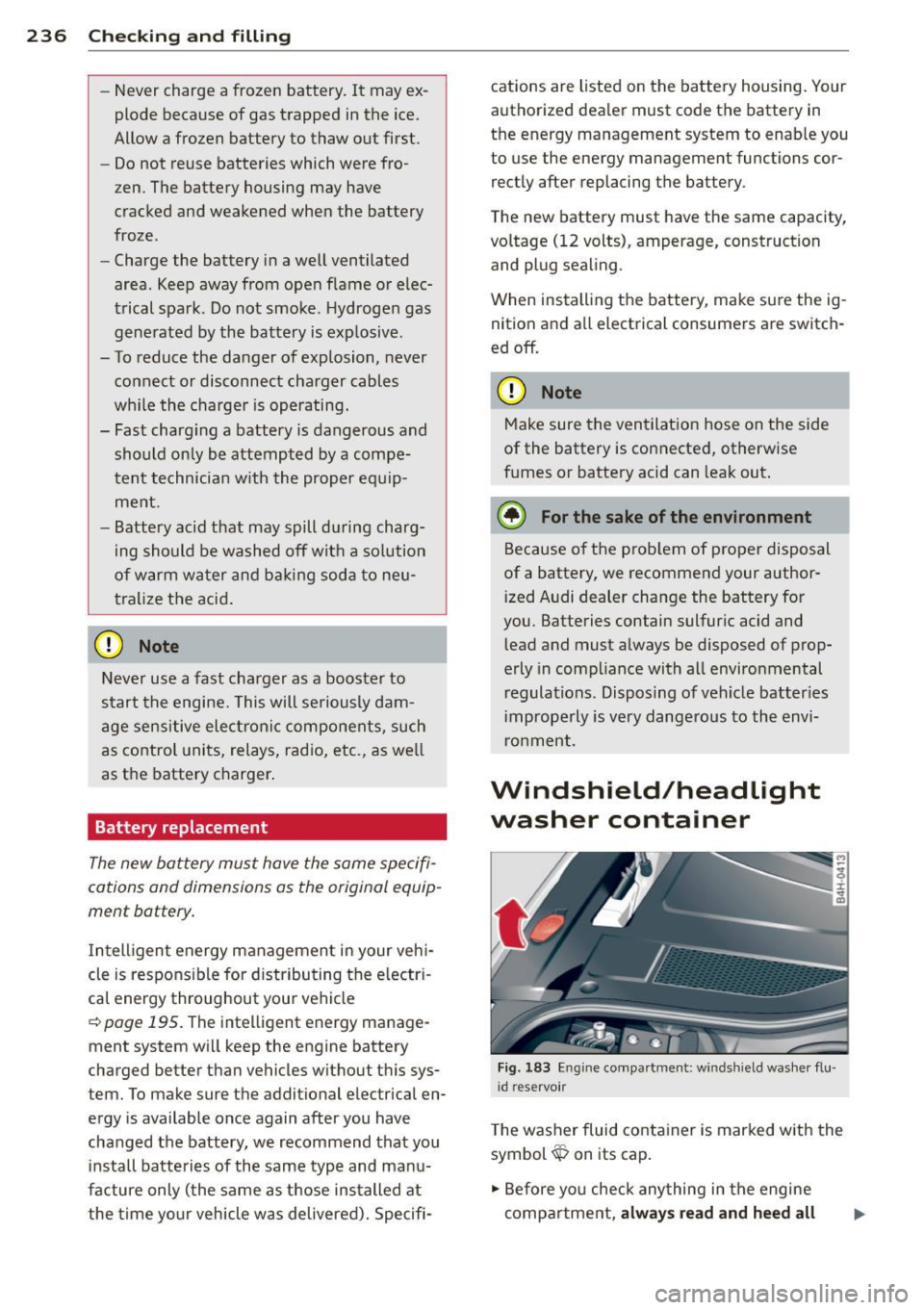
236 Checking and filling
-Never charge a frozen battery. It may ex
plode because of gas trapped in the ice.
Allow a frozen battery to thaw out first.
- Do not reuse batteries which were fro
zen. The battery housing may have cracked and weakened when the battery
froze .
- Charge the battery in a well ventilated
area . Keep away from open f lame or elec
trical spark . Do not smoke. Hydrogen gas
generated by the battery is exp losive.
- To reduce the danger of explosion, never
connect or disconnect charger cables
wh ile the charger is operating.
- Fast charg ing a battery is dangerous and
should only be attempted by a compe
tent technician with the proper equip
ment.
- Battery acid that may spill during charg
ing should be washed
off with a solution
of warm water and bakin g soda to neu
tralize the acid.
Never use a fast charger as a booster to
start the engine. This will se riously dam
age sensitive electronic components, such
as control units, relays, radio, etc., as we ll
as the battery charger .
Battery replacement
The new battery must have the same specifi
cations and dimensions as the original equip
ment battery.
I ntell igent energy management in your vehi
cle is respo nsible for distributing the electr i
cal energy throughout your vehicle
c::> page 195. The intelligent energy manage
ment system wi ll keep the engine battery
charged better than vehicles without this sys
tem. To make sure the additional electrical en
ergy is available once again after you have
changed the battery, we recommend that you install batte ries of the same type and man u
facture only (the same as those installed at
the time your vehicle was delivered). Specifi- cations are listed on the
battery housing. Your
authorized dealer must code the battery in
the energy management system to enab le you
to use the energy management functions cor
rectly after replacing the battery.
T he new battery must have the same capacity,
voltage (12 volts), amperage, construction and plug sealing .
When installing the battery, make sure the ig
nition and all electrical consumers are switch
ed off.
(D Note
Make sure the ventilation hose on the side
of the battery is connected, otherwise
fumes or battery acid can leak out .
@ For the sake of the environment
Because of the prob lem of proper disposal
of a battery, we recommend your author
i zed Audi dealer change the battery for
you. Batteries contain sulfuric acid and
lead and must always be disposed of prop
erly in compliance with a ll environmental
regulations. Disposing of veh icle batter ies
improperly is very dangerous to the envi
ronment .
Windshield/headlight
washer container
Fig. 183 En g in e compa rtm ent: w indshi eld washe r flu
i d reservo ir
T he washer fluid conta iner is marked w ith the
symbol~ on its cap .
.,. Before you check anything in the engine
compartment,
always read and heed all
Page 275 of 302
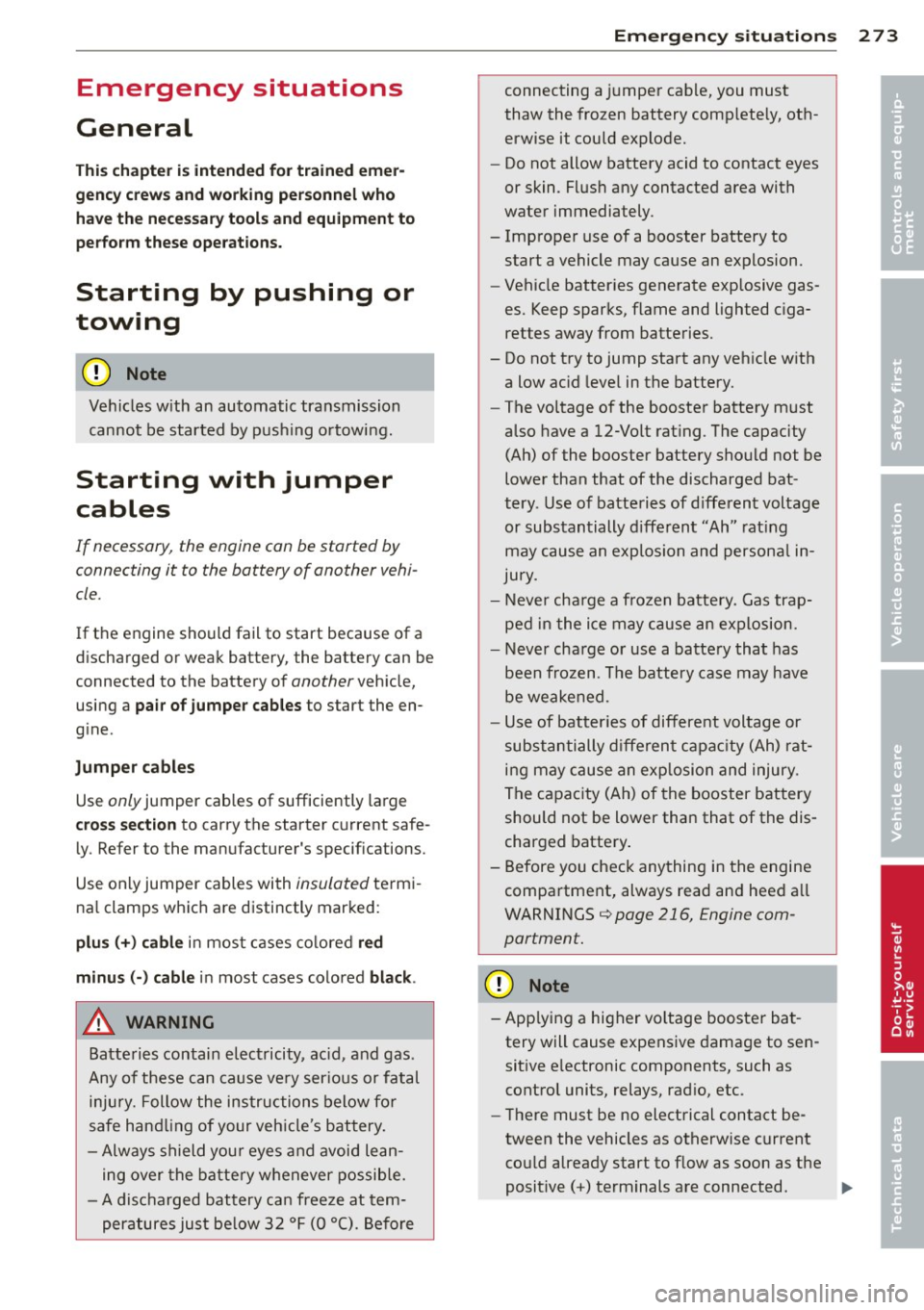
Emergency situations
General
This chapter i s intended for trained emer
gency crews and working personnel who have the necessary tools and equipment to
perform these operations.
Starting by pushing or
towing
CD Note
Ve hicles w ith an automatic tra nsmission
cannot be started by pus hing o rtowi ng.
Starting with jumper
cables
If necessary, the engine can be started by
connecting it to the battery of another vehi
cle.
If the engine shou ld fail to start because of a
discha rged o r wea k battery, the battery can be
connected to the battery o f
another vehicle,
using a
pair of jumper cables to start the en
g ine.
Jumper c ables
Use only jumper cables of sufficiently la rge
c ross section to carry the starter c urrent safe
l y . Refer to the man ufacturer's specifications.
Use only jumper cables with
insulated te rm i
na l clamps wh ic h are d istinctly mar ked:
plus(+) cable in mos t cases co lore d red
minus (-) cable
in most cases colored black .
A WARNING
Batterie s contain e lec tricity, ac id, an d gas.
Any of these can cause ve ry ser io us or fatal
inju ry. Follow the ins tructions below f or
safe han dling of your veh icle's b attery .
- Alway s sh ield you r eye s and avoid lean
i n g over the bat te ry w henever possib le.
- A dis ch arged battery c an free ze at tem
pera tures ju st below 3 2 °F ( 0 °C ). Befo re
Emergency situations 273
connecting a jumpe r cab le, you must
thaw the fr ozen battery c omp lete ly, ot h
erwise it could explode.
- Do not allow battery acid to contact eyes
or skin. Fl ush any contacted area with
wate r immediately .
- Improper use of a booster battery to start a vehicle may cause an explosion.
- Vehicle batter ies genera te exp losive gas
es. Keep spar ks, flame and lighted c iga
rettes away from batte ries.
- Do not try to jump start any ve hicle w ith
a low ac id leve l in the battery.
- The vo ltage of the booste r batte ry m ust
a lso have a 12-Vol t rating. T he capacity
(Ah) of the booster battery sho uld not be
lowe r tha n that of the discharged bat
tery . U se of batte rie s of d iffe ren t voltage
or substantially d iffe rent "Ah" rat ing
may c au se an exp losion and persona l in
Ju ry.
- N ever cha rge a fro zen battery. Gas tr ap
pe d in the i ce m ay cause a n ex plosion.
- Never cha rge or use a batte ry tha t h as
been fr ozen . T he battery case may have
be weakened.
- Us e of batter ies of differe nt voltage or
sub stant ia lly diffe ren t ca pa city (Ah) rat
i ng may c ause an exp losion an d injury .
Th e capac ity (Ah) of the booster bat tery
should not be lower than that of the dis
charged batte ry .
- Before you chec k any thing in the engine
compa rtment, always read and hee d all
WARNINGS
¢page 216, Engine com
partment.
CD Note
- App lying a higher voltage booster ba t
tery will cause expens ive damage to se n
sit ive e lectronic components, such as
cont rol units, relays, rad io , etc.
- There must be no electrical contact be
tween the vehicles as otherwise current
cou ld already start to f low as soon as the
posit ive(+) term inals a re connected. ..,. •
•
Page 293 of 302

Pressure malfunction ................ 16
Recomm end ed oil check int ervals .. .. . 227
Senso r defective . . . . . . . . . . . . . . . . . . . . 20
Spe cificat ion and visco sity .. .. .. .. .. . 224
En gin e speed limitat ion ..... .. .. .. .. .. 20
Eng ine start system (indicator lights) .... 17
Entry assistance . . . . . . . . . . . . . . . . . . . . . 60
Environm ent
Break-in period ......... .. .... .. .. . 197
Cata lytic converter .......... .. .... . 198
Disposing of your vehicle battery .... . 236
Driving at high speeds ........... .. . 200
Driving to minimize pollution and noise 199
Fuel ... .. .. .. .. ........... .. .. .. . 220
Fuel economy ............ .... .. .. . 199
Leaks under your veh icle ...... .. .... 222
Lettin g the vehicle stand and warm up. 200
Proper disposal of drained brake fluid . 232
Proper disposal of drained engine cool-
ant ... .. .. .... ............. .. .. . 230
Proper disposal of drained engine
oil . . . . . . . . . . . . . . . . . . . . . . . . . 227, 228
Recycling used engine oil ... .. .. .. .. . 227
Unleaded fuel ............ .... .. ... 218
What should I do with an old battery? . 236
ESP (Electronic stabilization program)
Warning/indicator lights ... .. .. .. .. .. 18
Event Data Recorder (EDR) ...... .. .... 190
Exhaust tail pip es .......... .... .. .. . 212
Expa nsion tank ............ .. .. .. .. . 229
Exterior lighting .............. ... ... . 43
Exterior mirrors
Ad justing .. .. ........... .. .. .. .... 51
Dimming . .. ............. .... .. .... 51
H eating .. .. ............. .... .. .... 51
Exterior temperature display ... .. .. .. .. 23
F
Fast ening
Booster seats .. .......... .. .. .. .. . 17 7
Convertible child safety seats ..... .. . 175
Infant seats . ............ .. .. .. ... 174
Floor mats . .. ............. .... .. .. . 133
Foot pedals .. .... ......... .... .. .. . 132
Index 291
For the sake of the environment
Gasoline fumes and the environment .. 220
Reducing engine noise by early upshift-
ing ......... .. .. .................. 10
Refueling ... .. .. .... ............. 220
Saving fuel by early upsh ifting ...... .. 10
Four zone automatic climate control .. ... 75
Front airbags Description . . . . . . . . . . . . . . . . . . . . . . . 149
How they work ... .. . .......... .... 1S4
Frontal coll is ion s and the laws of physics 138
Front passenger seat adjustment . . . . . . . 60
Front seats . . . . . . . . . . . . . . . . . . . . . . . . . S4
Adjus ting ... .. .. .. .. ........... .. 129
Child restraints in the front seat ...... 147
Fuel Additives ........ .. ............... 218
Blended gasoline .................. 218
Current consumpti on ........... .. .. . 24
Economy messages (efficiency program) 25
Fuel filler flap emergency release ... .. 221
Fuel filler neck ...... .... ...... .. .. 219
Fuel gauge . . . . . . . . . . . . . . . . . . . . . . . . 11
Gasoline .. .. .. .. .. .. ........... .. 218
Gasoline addit ives ................. 219
Low fuel level symbol . . . . . . . . . . . . . . . 20
Octane rating .. .. .. . .. .. ...... .. .. 218
Recommendation ................. . 218
Refuelling ... .. .. .... ............. 220
Reserve ..... .. .. ................. . 11
Ta nk capacity . . . . . . . . . . . . . . . . . 11, 282
Fuses Ass ignment ...... ............... . 268
Replacing ... .. .. ... ............ .. 268
G
Garage door opener (Homelink ®) .. ... . 124
Garment hooks .. .. ................. . 71
Gas discharge lamps .... ............. 272
Gauges Engine coolant temperature . . . . . . . . . . 10
Fuel gauge . . . . . . . . . . . . . . . . . . . . . . . . 11
Speedometer . . . . . . . . . . . . . . . . . . . . . . 26
Tachom eter ... .. ................. . 11
T rip odometer . .. .... ........... .. . 26
General illustration . . . . . . . . . . . . . . . . . . . 8
Generator (warning/indicator lights) ... . 16
•
•